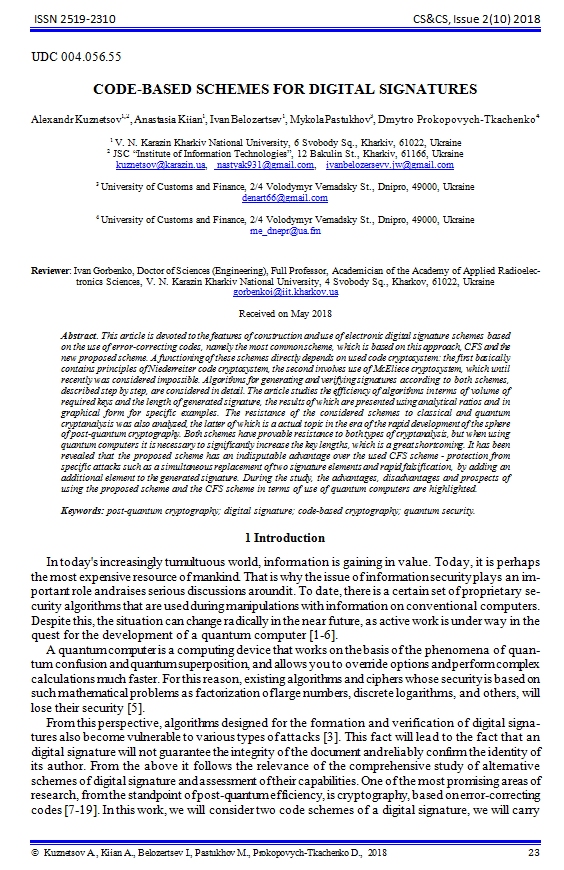Code-based schemes for digital signatures
Abstract
This article is devoted to the features of construction and use of electronic digital signature schemes based on the use of error-correcting codes, namely the most common scheme, which is based on this approach, CFS and the new proposed scheme. A functioning of these schemes directly depends on used code cryptosystem: the first basically contains principles of Niederreiter code cryptosystem, the second involves use of McEliece cryptosystem, which until recently was considered impossible. Algorithms for generating and verifying signatures according to both schemes, described step by step, are considered in detail. The article studies the efficiency of algorithms in terms of volume of required keys and the length of generated signature, the results of which are presented using analytical ratios and in graphical form for specific examples. The resistance of the considered schemes to classical and quantum cryptanalysis was also analyzed, the latter of which is a actual topic in the era of the rapid development of the sphere of post-quantum cryptography. Both schemes have provable resistance to both types of cryptanalysis, but when using quantum computers it is necessary to significantly increase the key lengths, which is a great shortcoming. It has been revealed that the proposed scheme has an indisputable advantage over the used CFS scheme - protection from specific attacks such as a simultaneous replacement of two signature elements and rapid falsification, by adding an additional element to the generated signature. During the study, the advantages, disadvantages and prospects of using the proposed scheme and the CFS scheme in terms of use of quantum computers are highlighted.
Downloads
References
A.J. Menezes, P.C. van Oorschot, S.A. Vanstone. Handbook of Applied Cryptography. CRC Press, 1997, 794 р.
N. Ferguson and B. Schneier. Practical Cryptography. John Wiley & Sons, 2003, 432 p.
D. Bernstein, J. Buchmann and E.Dahmen. Post-Quantum Cryptography. Springer-Verlag, Berlin-Heidleberg, 2009, 245 p.
J. Proos and Ch. Zalka. “Shor’s discrete logarithm quantum algorithm for elliptic curves”. [On-line]:https://arxiv.org/abs/quant-ph/0301141.
D. Deutsch and R. Jozsa. “Rapid solutions of problems by quantum computation”. Proceedings of The Royal Society of London A: Mathematical, Physical and Engineering Sciences, Vol. 439, No. 1907. – 1992. pp. 553-558.
P.W. Shor. “Polynomial-Time Algorithms for Prime Factorization and Discrete Logarithms on a Quantum Computer”. Foundations of Computer Science: Conference Publications, 1997, pp. 1484-1509.
Niederreiter, H. “Knapsack-type cryptosystems and algebraic coding theory”. Problem Control and Inform Theory, 1986, V. 15. pp. 19-34.
Yu.V. Stasev, A.A. Kuznetsov. “Asymmetric code-theoretical schemes constructed with the use of algebraic geometric codes”. Kibernetika i Sistemnyi Analiz, No. 3, pp. 47-57, May-June 2005.
A. Kuznetsov, I. Svatovskij, N. Kiyan and A. Pushkar'ov. "Code-based public-key cryptosystems for the post-quantum period, "2017 4th International Scientific-Practical Conference Problems of Infocommunications. Science and Technology (PIC S&T), Kharkov, 2017, pp. 125-130.
A. Kuznetsov, R. Serhiienko and D. Prokopovych-Tkachenko. "Construction of cascade codes in the frequency domain, "2017 4-th International Scientific-Practical Conference Problems of Infocommunications. Science and Technology (PIC S&T), Kharkov, 2017, pp. 131-136.
Yu.V. Stasev, A.A. Kuznetsov. “Asymmetric Code-Theoretical Schemes Constructed with the Use of Algebraic Geometric Codes.” Cybernetics and Systems Analysis, Vol. 41, Issue 3, pp. 354-363, May 2005.
M. Finiasz and N. Sendrier. “Security bounds for the design of codebased cryptosystems”. In M. Matsui, ed., Advances in Cryp-tology, ASIACRYPT 2009, Vol. 5912 of Lecture Notes in Computer Science. -Springer Berlin Heidelberg, 2009, pp. 88-105.
N.Courtois, M.Finiasz and N.Sendrier. “How to achieve a McEliece-based digital signature scheme”. In Advances in Cryptology - ASIACRYPT 2001, Vol. 2248, pp. 157–174.
M. Finiasz “Parallel-CFS: Strengthening the CFS McEliece-based signature scheme”. In Biryukov A., Gong G., Stinson D., eds.: Selected Areas in Cryptography. Vol. 6544 of LNCS., Springer (2010) pp.159-170.
J. Stern “A new identification scheme based on syndrome decoding”. In Advances in Cryptology - CRYPTO’93, Vol. 773 of LNCS. Springer Verlag (1994).
R. J. McEliece “A public-key cryptosystem based on algebraic coding theory”. DSN Progress Report 42-44, Jet Propulsion Lab., Pasadena, CA, January-February, 1978, pp. 114-116.
V. M. Sidel'nikov “Kriptografiya i teoriya kodirovaniya”. Materialy konferentsii «Moskovskii universitet i razvitie kriptografii v Rossii», MGU. – 2002. – 22 p. (in Russian).
S. Sander “Study of McElice cryptosystem”. [On-line]: https://courses.cs.ut.ee/MTAT.07.022/2015_spring/uploads/Main/sander-report-s15.pdf.
Li, Y. X., Deng, R.H., Wang, X.M. “On the equivalence of McEliece’s and Niederreiter’s public-key cryptosystems”. [On-line]: https://ieeexplore.ieee.org/document/272496/.
Clark, G.C., Cain, J.B. Error-Correction Coding for Digital Communications. Springer, 1981, 432 p.


